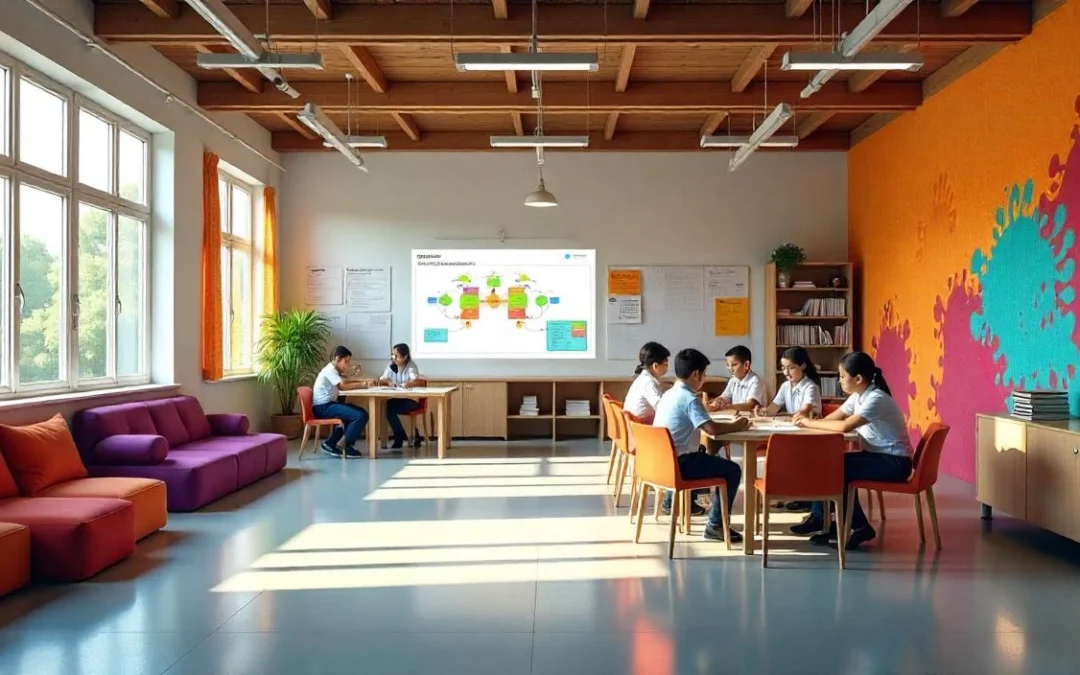We live in a world that is rapidly evolving with technological advancements and global challenges. Therefore, the education system needs to adapt to equip students with the skills and mindset to thrive. Among the most transformative approaches in education today is the integration of Design Thinking—a methodology that fosters creativity, problem-solving, and innovation. By embedding Design Thinking in Schools curriculums, educators can prepare students not just for academic success but for meaningful contributions to society.
What is Design Thinking?
Design Thinking in Schools is a human-centered approach to problem-solving that involves understanding users, redefining problems, and creating innovative solutions. It encourages collaboration, critical thinking, and experimentation, moving away from rigid educational norms to embrace curiosity and creativity
The five key stages of Design Thinking are:
- Empathize: Understanding the needs of users or stakeholders.
- Define: Clearly stating and understanding the issue that needs to be addressed.
- Ideate: Brainstorming and generating creative solutions.
- Prototype: Building tangible representations of ideas.
- Test: Evaluating and refining the solutions.
This iterative process equips students with the ability to tackle complex problems with confidence and ingenuity.
Why is Design Thinking Essential in Schools?
- Encourages Creativity and Innovation
Traditional education often prioritizes rote learning and standardized testing, leaving little room for creative exploration. Design Thinking in Schools, on the other hand, emphasizes out-of-the-box thinking. It encourages students to view challenges as opportunities for innovation, making them active participants in their learning journey.
For example, a classroom project to design eco-friendly packaging can spark creativity while teaching environmental awareness and critical thinking.
- Develops Problem-Solving Skills
In an increasingly complex world, problem-solving is a vital skill. Design Thinking in Schools teaches students to approach problems systematically, from understanding the root cause to developing and testing solutions. These skills are transferable to various domains, from science and technology to social issues and entrepreneurship
- Builds Empathy
At its core, Design Thinking is about understanding and addressing human needs. By focusing on empathy, students learn to view problems from multiple perspectives, fostering compassion and inclusivity. This is especially important in creating a more harmonious and collaborative society.
- Prepares Students for Future Careers
The job market of the future demands adaptability, creativity, and collaborative skills. Industries like technology, healthcare, and business increasingly value employees who can think critically and innovate. By embedding Design Thinking in Schools into education, schools ensure that students are ready to meet these demands
- Promotes Collaboration
Design Thinking thrives on teamwork. Students learn to communicate effectively, listen to diverse viewpoints, and work together to achieve common goals. These collaborative experiences prepare them for real-world scenarios where teamwork is essential.
How to Incorporate Design Thinking in Schools
- Project-Based Learning (PBL)
Integrating Design Thinking into project-based learning is a powerful way to engage students. Teachers can design projects that address real-world challenges, encouraging students to empathize, ideate, prototype, and test solutions.
Example: A project to design affordable housing solutions for low-income families can combine math, science, and social studies, while also fostering empathy and innovation.
- STEAM Education
Design Thinking complements STEAM (Science, Technology, Engineering, Arts, and Mathematics) education by emphasizing creativity alongside technical skills. Through hands-on activities like robotics, coding, and art-based problem-solving, students can apply their knowledge in meaningful ways.
- Maker Spaces
Schools can establish maker spaces equipped with tools and materials for prototyping and experimentation. These spaces encourage students to bring their ideas to life, promoting a culture of innovation and discovery.
- Teacher Training
Teachers play a crucial role in fostering a Design Thinking mindset. Professional development programs can equip educators with the skills to guide students through the Design Thinking process effectively.
- Cross-Disciplinary Approaches
Design Thinking transcends subject boundaries, making it ideal for interdisciplinary learning. For instance, a project on designing sustainable energy solutions can combine physics, environmental science, and economics.
Design Thinking in Action
Many schools with the help of Techradiance have pioneered the use of Design Thinking in education, inspiring schools worldwide to adopt similar approaches. Their programs emphasize empathy and creativity, enabling students to tackle complex societal issues.
Design for Change
An international initiative, Design for Change empowers students to solve real-world problems in their communities using Design Thinking in Schools. Projects range from creating water-saving solutions to addressing bullying in schools, showcasing the transformative power of this methodology.

Design Thinking in Schools
Riverside School, India
Reportedly, the Riverside School in Ahmedabad, India, has successfully integrated Design Thinking in Schools into its curriculum. Students engage in projects that address local and global challenges, such as improving road safety or reducing plastic waste, fostering a sense of responsibility and innovation.
The Benefits of Design Thinking in Education
- Holistic Development
Design Thinking nurtures a range of skills, including critical thinking, emotional intelligence, and creativity. This holistic approach ensures that students grow not just academically but also as empathetic and innovative individuals.
- Increased Engagement
Students are more engaged when they understand how their learning applies to real life. Design Thinking projects connect classroom knowledge to real-world applications, making education meaningful and engaging.
- Improved Academic Performance
By fostering a deeper understanding of concepts through hands-on activities, design thinking can enhance academic performance. Students develop problem-solving and analytical skills that benefit them across subjects. Machine learning course
- Fostering a Growth Mindset
Design Thinking encourages students to embrace failure as a step toward success. This growth mindset helps them overcome challenges with resilience and determination.
Overcoming Challenges in Implementation
While the benefits of Design Thinking are clear, implementing it in schools comes with challenges. These include:
- Resistance to Change: Educators and administrators may hesitate to shift from traditional methods.
- Resource Constraints: Not all schools have the resources to create maker spaces or provide teacher training.
- Assessment Issues: Measuring creativity and problem-solving is more complex than grading standardized tests.
To overcome these challenges, schools can start small by integrating Design Thinking in Schools into specific projects or subjects, gradually expanding its scope as they gain experience. Collaborating with organizations and leveraging digital tools can also help address resource constraints.
The Future of Design Thinking in Schools
As the world continues to evolve, the importance of fostering creativity and innovation in education cannot be overstated. Design Thinking offers a powerful framework to prepare students for the challenges and opportunities of the future. By prioritizing empathy, collaboration, and problem-solving, schools can nurture a generation of thinkers, creators, and leaders who are ready to make a positive impact on the world. Composite laboratory

